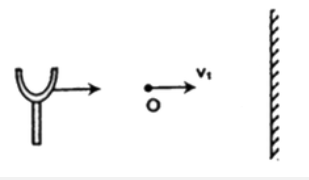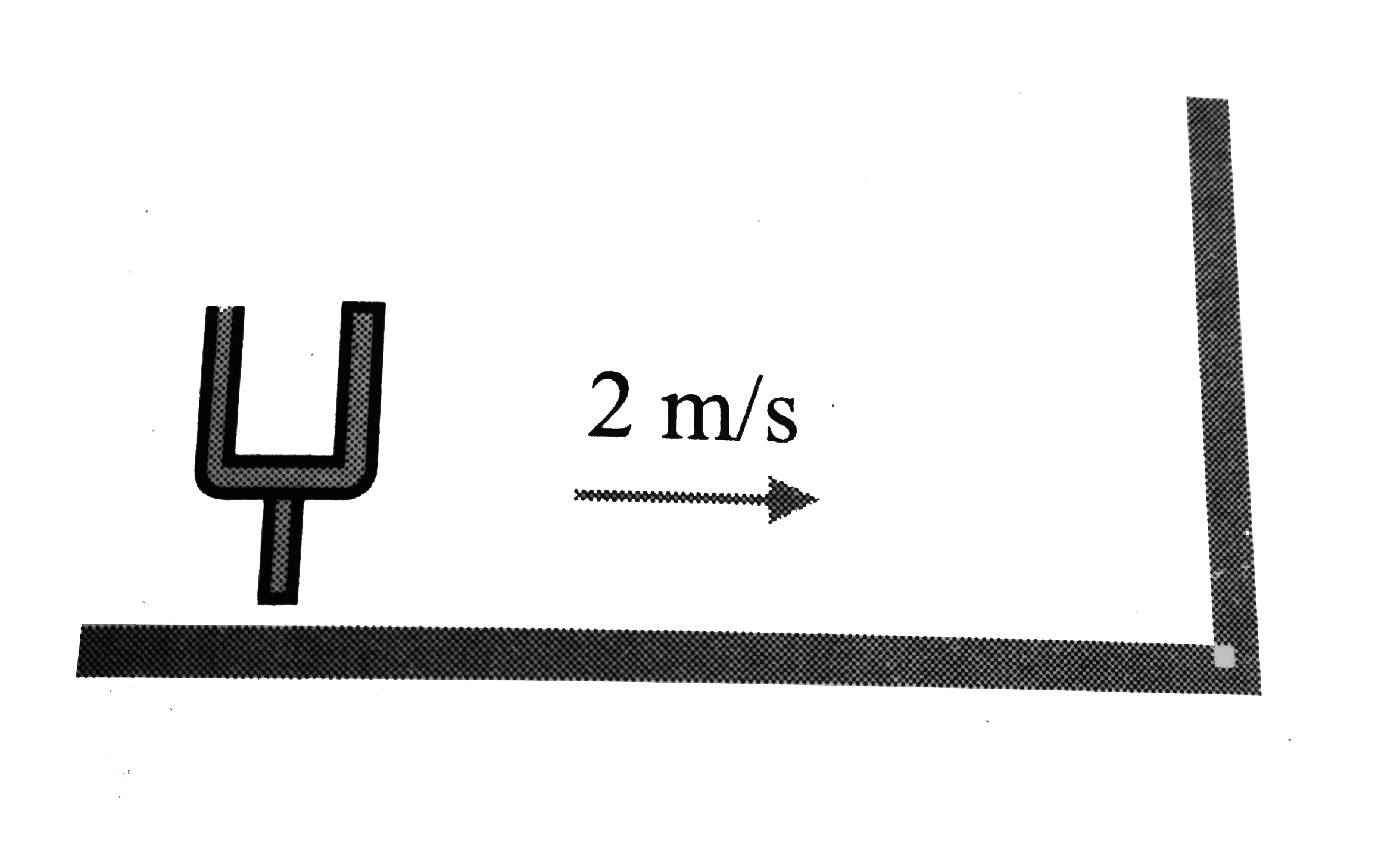A student holds a tuning fork ocillating at 2456 Hz. He walks towards a wall at a constant speed of . (a) What beat frequency does the student observes between the tuning fork and its echo? (b) How fast must he walk away from the wall to observe a beat frequency of ?
An electronic burglar detector may listen for beasts between the signal it broadcasts and the Doppler shifted reflection from a moving surface. The experiment described here is more fun. The student hears beats at a rate that is controlled through his walking speed. We must thinks of a double Doppler shift, for the wave reaching the wall from the moving tuning fork and the wave reaching the moving auditor.
For this echo,
where is the magnitude of the experimenter's velocity the beat frequency is
Substituting gives
When approaching the wall
a.
b. When moving away from wall appears with opposite signs, Solving for gives
Topper's Solved these Questions
- BOOK - CENGAGE PHYSICSCHAPTER - SOUND WAVES AND DOPPLER EFFECTEXERCISE - Exercise 6.156videos
SOUND WAVES AND DOPPLER EFFECT
- BOOK - CENGAGE PHYSICSCHAPTER - SOUND WAVES AND DOPPLER EFFECTEXERCISE - Exercise 6.272videos
SOUND WAVES AND DOPPLER EFFECT
- BOOK - CENGAGE PHYSICSCHAPTER - SOUND WAVES AND DOPPLER EFFECTEXERCISE - Integer16videos
SOUND WAVES AND DOPPLER EFFECT
- BOOK - CENGAGE PHYSICSCHAPTER - RIGID BODY DYNAMICS 2EXERCISE - Interger2videos
RIGID BODY DYNAMICS 2
- BOOK - CENGAGE PHYSICSCHAPTER - SUPERPOSITION AND STANDING WAVESEXERCISE - Comprehension Type5videos
SUPERPOSITION AND STANDING WAVES
Similar Questions
There is a source of sound (a tuning fork) moving towards a reflecting wall will a speed of 30ms−1. The velocity of the sound in air is 330ms−1and the frequency of the tuning fork is 600 Hz. The observer is between the source and the wall and is moving with some velocity V1 towards the wall. The beat frequency heard by the observer is 4 Hz. If the tuning fork is waxed, the frequency beats heard by the observer becomes 3 Hz. If the new frequency of tuning fork is k then k/50 is
 View Solution
View SolutionA source of sound with frequency 256Hz is moving with a velocity V towards a wall and an observer is stationary detween the source and the wall. When the observer is between the source and the wall he will hear beats.
View Solution
Knowledge Check
- Question 1 - Select One
A student holds a tuning fork oscillating at 170 Hz. He walks towards a wall at a constant speed of 2 ms−1 The beat fequency observed by the student between the tuning fork and its echo is (Velocity of sound =342 ms−1 )
A2.5 HzB3 HzC1 HzD2 Hz - Question 2 - Select One
A car blowing a horn of frequency 350 Hz is moving normally towards a wall a speed of 5 m/s The beat frequency heard by a person standing between the car and wall is (speed of sound in air =350 m/s )
A0B3.5 HzC5 HzD10 Hz - Question 3 - Select One

As shown if Fig. a vibrating tuning fork of frequency 512 Hz is moving towards the wall with a speed 2ms. Take speed of sound as v=340ms and answer the following questions.
Q. Suppose that a listener is located at rest between the tuning fork and the wall. Number of beats heard by the listener per second will beA4B3C0D1
(a) A tuning fork produces 4 beats per second with another tuning fork of frequency 256Hz. The first one is now loaded with a little wax and the beat frequency is found to increase to 6 per second. What was the original frequency of the tuning fork ?
(b) A plano wire A vibrates at a fundamental frequncy of 600Hz. A second identical wire B produces 6 betas per second with it, when of the tension in A is slightly increased. Find the ratio of the tension in A to the tension to B.
( c) A tunnig fork if frequency 256Hz produces 4 beats per second with a wire of length 25cm vibrating in its fundamental mode. The beat frequency decreases when the length is slightly shortened. What could be the minimum length by whech the wire be shortened so that it produces no beats with the tuning fork?View SolutionA tuning fork of frequency 256hZ is moving towards a well with a velocity of 5m/s . If the speed of sound is 330m/s , then the number of beats heard per second by a stationary observer lying between tuning fork and the well is
View SolutionA man stands at rest in front of a large smooth wall. Directly in front of him, between him and the wall he holds a vibrating tuning fork of frequency 400Hz. He now moves the fork towards the wall with a speed of 1m/s. How many beats/s will he hear between the sound waves reaching him directly from the fork, and those reaching him after being reflected from the wall ?
View SolutionA tuning fork of frequency 328Hz is moved towards a wall at a speed of 2ms−1. An observer standing on the same side as the fork hears two sounds, one directly from the fork and the other reflected from the wall. Number of beats per second is (Velocity of sound in air 330ms−1).
View SolutionA tuning fork produces 5 beats s−1 with a sonometer wire of length 78 cm. If the length of the wire iscreased byy 2 cm, then there is a resonance between the tuning fork and the wire. The frequency of the fork is
View Solution

